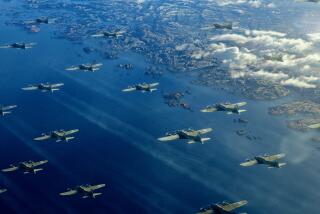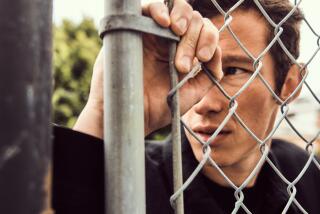Remembering World War II Cameramen
During World War II, combat camera operators fought the war in the European, African and Pacific theaters not with guns, but with Bell and Howell’s Eyemo cameras--hand-held, hand-wound 35-millimeter machines that carried two-minute film loads. These enlisted men were given a minimum amount of training before they were sent out to record the global conflict’s fiercest battles. The photographers also captured the conflict with 16-millimeter color cameras.
“Shooting War,” an ABC documentary celebrating the work of these men, airs Thursday on the 59th anniversary of the Japanese attack on Pearl Harbor. Steven Spielberg served as its executive producer, and Tom Hanks, who starred in Spielberg’s 1998 World War II epic, “Saving Private Ryan,” is the host.
Historian and Time magazine film critic Richard Schickel wrote, produced and directed the special, which draws on more than 600 hours of archival footage and features interviews with 25 veteran photographers.
Schickel, who has been nominated for four Emmys, talked about the film, which was nearly two years in the making.
Question: Where did most of the footage come from?
Answer: I would say 98% came out of the National Archives in Washington. We had literally millions of feet of footage in our cutting room . . . we had a huge retrieval problem with this show. We had to create a database on a computer in order to handle the material. I’d see some great thing as it would flash by me as we were looking through what amounted to all of these millions of feet of film, and two months later I’d say [to the editor], “Do you remember that dogfight?” And he would go crazy. He’d say, “Wait a minute. We have seen 50 dogfights.” Then we couldn’t find it. So I was very frustrated a year ago last summer. We had all of this material we knew was good. I had all of these interviews I knew were good. But matching up the footage to the interviews was just extremely difficult.
Q: Did you have anyone helping you?
A: We had a great researcher in Washington . . . Mel Paisley, who was himself a fighter pilot during the war. His kind of hobby and passion is the National Archives and especially World War II footage. So without him, I don’t think we could have done the film. Just to kind of go into the National Archives cold and say, “I’d like to see what you have on World War II,” would just be ridiculous. But Mel . . . knew the people there, and he knew the footage.
Q: I don’t think this battle footage has been presented like this before.
A: People tend to use World War II footage kind of generically, in particular the air and carrier war in the Pacific. They just mush all of that stuff together. We were able to be really very particular. That really great sequence of the kamikaze plane [dive bombing]--that is the real deal. That is what this guy saw. It was interesting to me how absolutely accurate everybody’s memory was. They would say they shot something and, by God, you would turn up the film and it would exactly match what they just said to me.
Q: One of the most haunting and disturbing scenes was when the Japanese woman fleeing the American soldiers throws her baby in the ocean and then jumps into the water herself.
A: I have shown this thing in public twice, and the thing where the woman throws her baby over the cliff and then jumps in after it--that just brings people. . . . The response to that sequence is just amazing.
Q: Were they also stunned seeing the gruesome scene of the dead and bloated Mussolini propped up against the wall with the head of his executed mistress resting on his shoulder?
A: I was not that familiar with that footage. I have seen footage of the bodies strung up at the gas station in Milan. It is spooky.
One of the things that Steven [Spielberg] did say to me is, “This is war; I don’t want you to blink from the carnage. I want people to understand that people get hurt and die. That is what war is.”
Q: Did Spielberg come to you with this project?
A: We had at Time this big party [for the 75th anniversary of the magazine] at Radio City Music Hall three years ago, and Time asked me to work with Steven to put together a little seven- or eight-minute piece on John Ford. We kind of got to know each other . . . [later] I dropped Steven a note and said maybe we should do John Ford’s war. He faxed back and said, “Let’s do all the combat cameramen of World War II.” He gave us our title, and he talked to Tom Hanks about appearing in the show.
Q: Did you find a pattern in the personalities of these combat photographers?
A: They range from being kind of ironic to being passionate. They are the guys who say to you, “You should see the stuff I missed because I was loading my camera.” There is a kind of, I think, antiheroic [aspect to them]. None of them forgot [the war]. Those are very vivid memories for them, but, on the other hand, life has gone on and they have done other things.
* “Shooting War” airs Thursday at 9 p.m. on ABC.
More to Read
Only good movies
Get the Indie Focus newsletter, Mark Olsen's weekly guide to the world of cinema.
You may occasionally receive promotional content from the Los Angeles Times.











